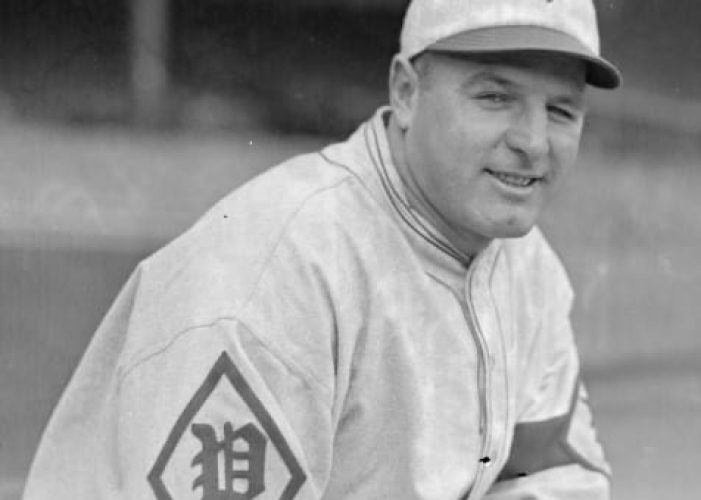Buzz Arlett Essentials
Positions:
Bats: B Throws: R
75 Weight: 225
Born: 1 3, 1899 in Elmhurst, CA USA
Died: 5 16 1964 in Minneapolis, MN USA
Debut: 4/14/1931
Last Game: 9/27/1931
Full Name: Russell Loris Arlett
Russell Loris “Buzz” Arlett
Buzz Arlett had some things in common with Babe Ruth. He was a big man for his era (6’4”, 230 lbs.), started his career in the first decade of the 20th Century, and was famous for his power. The difference was Buzz hit most of his home runs in the minor leagues. Four years younger than the Babe, he began his career with the Oakland Oaks of the Pacific Coast League. The PCL was the highest grade of baseball played in the west and many called it the third major league.
Arlett played sparingly in the field during his first five seasons in Oakland. The big righty was originally used on the mound, with occasional pinch-hit appearances until 1923. Ironically, an arm injury ended his pitching career. Incredibly, the arm injury caused Buzz to turn around (batting left-handed) and he became a switch hitter! Playing outfield, and some first base, he batted .330 in 149 games and showed power with 19 home runs and 101 RB in 1923. He would play 12 seasons with the Oaks.
From 1923 to 1930, Arlett hit 237 home runs and drove in 1100 runs. He also added 427 doubles (averaging an incredible 54 per season!) and 78 triples during that period. Buzz also displayed good speed, adding 145 stolen bases.
Though he had been scouted by multiple big league teams, Arlett was considered a poor fielder and said to lack concentration when his team fell behind. Also holding him back was being under contract with Oakland. Many owners of top minor league teams demanded high prices for their stars. This became even worse during the Depression when money was so tight.
In 1930, Arlett was sought out by the Brooklyn Robins. Scouts reported that he was much improved in the field, and they coveted his bat.
During a game late in the season, Arlett was ejected by home plate umpire Chet Chadbourne for disputing calls. He stopped Chadbourne after the game seeking an explanation for his expulsion. An argument ensued and Chadbourne violently struck Arlett with his heavy facemask. The injury was extensive, and Buzz was cut to the bone above his left eye. Brooklyn withdrew interest and once again Arlett lost a chance to move up. Although he was exonerated of any fault in the argument, the false conclusion that he was hot-tempered caused other teams to lose interest. Also, advancing age was not on his side.
Finally in 1931, at the age of 32, Arlett received his chance in the major leagues. Oakland sold his contract to the Philadelphia Phillies. In 121 games with the Phillies, he batted .313 with 18 home runs and 72 RBI. In 469 plate appearances, he only struck out 39 times.
The mystery is: Why was this his only season in the major leagues?
Arlett’s 1931 season started hot, but injuries soon slowed him down, although he finished with respectable statistics. Management also believed he displayed an indifferent attitude much of the season. If he did get down when the team was losing, he had ample opportunities to do so with Philadelphia, a perennial loser. Philadelphia waived Arlett at the season’s end, and he went unclaimed by all 15 teams. Age and money were also a factor.
The next season he was back in the minor leagues with Baltimore (AA) of the International League. There certainly were no physical problems, as Arlett batted .339 with 54 home runs and 144 RBI with the Orioles. Buzz would go on to play five more seasons before ending his playing career. In his minor league career, he belted 432 home runs and drove home 1786 runs. His combined batting average was .341. His minor league home run record lasted until 2015 when Mike Hessman hit his 433rd, and last, home run of his 19-year career. Arlett’s home run record lasted 78 years, more than twice as long as Babe Ruth’s.
What could have been? Lefty O’Doul stated that if Arlett was given five seasons at the major league level, he would have been the Babe Ruth of the National League. The National League coveted the high-scoring prowess of their American League counterparts to the point where they discussed a DH (designated hitter) as far back as the 1928 winter meetings. Buzz Arlett may have been the perfect player for this.
✍️ Story by Skip Carpentier



